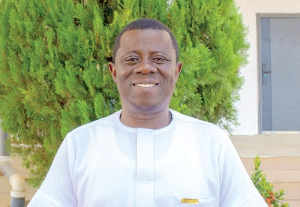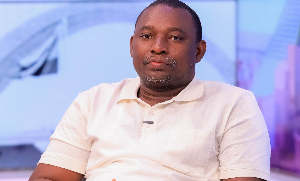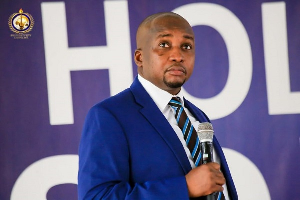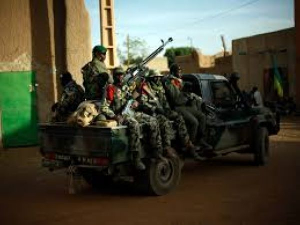Date: May 11, 2007
Dear Dagbana,
DAGBON CUSTOMS ON CHIEFTAINCY AND KINGSHIP FUNERALS
According to Dagbon customs it is mandatory for all chiefships that derive their title direct from the Ya-Naa to customarily attend in person (or by representatives where appropriate) to mourn the death of their customary father/grandson of the Ya-Naa, at his tomb and to perform customary rites.Also it is customarily mandatory for all chiefships that derive their title direct from the Ya-Naa to renew in the Gbewaa tradition, solidarity with the Nam (Kingship) when the Regent of Dagbon is installed.
DAGBON FUNERAL RITES: Dagbon funeral rites for Kings and Chiefs are well established by customs and traditions over centuries. Exceptions to the norm are also established by precedents. The procedural funeral rites for Late Kings and Chiefs (the norm) differ from those of Former Kings and Chiefs (the exceptional).
The funerals rites for Late Kings and Chiefs (those who have died in office), do take the normal procedure whilst those who have died out of office (former Kings and Chiefs) take the exceptional procedural funeral rites.
The exceptional procedural funeral rites is either that the funeral for a Former King or Chief can be performed shortly after his death, at his place of death, or the funeral rites are kept in abeyance until a direct relation of the Former King or Chief does occupy the deceased King’s office and die. When the funeral rites are being performed, the Former King’s/Chief’s funeral rites are jointly performed.
The rational for such exceptional procedure is to prevent conflicts within the Dagbon State and avoid the creation of parallel authority within the Dagbon State, such as what we are experiencing today.
Former Ya-Naa Mahamadu Abudulai’s funeral rites fall under the exceptional procedural funeral rites of Dagbon Custom. This is supported by the precedents of the three (3) Former Ya-Naas and other Dagbon Chiefs who did not die in office.
Funerals Of Former Ya-Naas: Ya-Naa Bukari Tanpiong-Karigu (1806) was deskinned. He died at Saakpili and his funeral was performed at Saakpili.
Ya-Naa Dahamani-kulkarijie (1899) was deskinned by the Abudu Royal Family, in conspiracy with Germany mercenaries. He died at Tugu-Juni and his first funeral rites were performed there. His final funeral rites were, however, customarily performed by Ya-Naa Mahama Kpema II (1948) when the latter become Ya-Naa. Ya-Naa Alhassan of Abudu Royal Family was one of the few Dagbon Chiefs who broke the Dagbon adage that ‘’deskinnment is unknown in Dagbon’’.
Ya-Naa Bukari-Bofo (1920-21) abdicated and died at Savulugu. His successor Ya-Naa Abudu II of Abudu Royal Family had Ya-Naa Bukari-Bofo of Andani Royal Family funeral performed at Savulugu.
Funerals Of Some Dagbon Chiefs Deskinned: Kariga-Naa/Sunson-Naa Yahaya was deskinned by Kariga-Naa Jatta. Naa-Yahaya died at Sunson and his funeral was performed at Sunson.
Savulugu-Naa/Tong-Lana Mahama Piegu was deskinned by the British Administration. He died as Ton-Lana and his funeral was performed at Tong village.
Demong-Naa Shiee (Garilli) was deskinned by the British Administration. He died at Yendi and his funeral was performed in his house at Yendi.
Gbulung-Lana Naatogima died. His family refused to perform his funeral. His final funeral rites were performed by his elder brother Gbulung-Lana Issaaka at Gbulung when the latter became Gbulung-Lana.
Gushie-Naa Mahamudu was deskinned. He went into self exile at Kolin-vaa, in Mampurigu, where he died and his funeral was performed at Kolin-vaa in Mampurigu.
Chiefs Not Deskinned Who Died Away From Their Stations (Exceptional Procedural Funeral Rites)
Yoo (Savulugu) Naa Mahami, the eldest son of Ya-Naa Abudulai I, died at Sati, in the present North Eastern Ghana, at the hands of Samori, a Zabarima slave raider from Niamey-Niger. His funeral was performed by his son Yoo-Naa Abudulai Gurigurilo Kpema just before ascending to ‘’Yoo (Savulugu) Nam’’.
Yoo (Savulugu) Naa Yiri, the eldest son of Ya-Naa Andani III (Girilon), was murdered at SANG on route to Savulugu from Yendi by German mercenaries commissioned by Ya-Naa Allassani of Abudu Royal Family. His funeral was performed by his younger brother Yoo-Naa Bukari Bofo before he ascended to ‘’Yoo-Nam’’.
Note: Dagbon State funeral is reserved for reigning Kings and not for former Kings
Funerals Of Enskinned Late Ya-Naas – (1543 – 1968) The 10th Ya-Naa Dariziegu died near Wa in the present Upper West of Ghana and his funeral (1554) was performed where he died by Ya-Naa Luro.
The 12th – 16th Ya-Naas: Titugiri to Zanjina died at Agbandi, East of Yendi, and their funerals were performed there. The 13th Ya-Naa Zagili died at Nassa and his funeral was performed at Nassa.
The 17th – 34th Ya-Naas: Andani Sigili to Andani Zolikugli died at Yendi. Their funerals were performed at Yendi at the Palace. Ya-Naa Sumani Zoli’s funeral was performed outside Yendi, at Dimon where he died.
An Exceptional Precedent For A Deceased Reigning King: The funeral of a customarily enskinned Ya-Naa who also died in office (and while his biological son was then the incumbent Ya-Naa) has ever been customarily performed, away from Gbewaa Palace, at Zohe west of Yendi town.
According to Dagbon customary practices all chiefs whose chiefship is derived direct from the Ya-Naa are customarily mandated to attend individually, in person, at the deceased Ya-Naa’s funeral. Any failure to observe this customary mandate might result in the deskinnment of the failed chief or exclude that chief from further promotion within the apprenticeship system of Dagbon that can lead a Chief Royal to the Kingship.
When Ya-Naa Mahama (Billa) III died in 1953, Kpatin-Lana Abudu Ziblim whom the Abudulai Royal Family had first preferred as the Regent of Dagbon bared Mion-Lana Andani from attending the funeral of Ya-Naa Mahama (Billa) III. It was a condition that would render Mion-Lana Mahama Andani disqualified to contest customarily, for the Kingship of Dagbon as a direct son of a Ya-Naa and who, at the time occupied a ‘’gate-chiefship’’ of Dagbon.
Mion-Lana Mahama Andani conferred with the then Kuga-Naa who in turn advised him to be patient in the interest of peace in Dagbon. That advice was accepted.
Seven (7) years later, however, in 1960, Mion-Lana Mahama Andani appealed to the government, in Cabinet, who empowered the Northern Regional Commissioner, Mr. E.A. Mahama to ensure that Mion-Lana Mahama Andani is permitted to perform the customary funeral rites of Ya-Naa Mahama (Billa) III.
Mion-Lana Mahama Andani customarily notified the then Kuga-Naa and Ya-Naa Abudulai (Billa) III about the Government’s approval for him to perform Ya-Naa Mahama (Billa) III’s funeral at such a late date. The then incumbent Ya-Naa’s approval was given Mion-Lana, Mahama Andani to perform the late Kings funeral subject to stated conditions.
He first attended at the tomb of the late Ya-Naa, Mahama (Billa) in ‘Katini House’’ where he performed some customary burial rites.
Ya-Naa Abudulai (Billa) III and the then Kuga-Naa ordered that Ya-Naa Mahama (Billa) III’s funeral should be performed by Mion-Lana Mahama Andani at Zohe (west of Yendi town) away from the Gbewaa Palace in accordance with Dagbon Custom.
The then incumbent Ya-Naa’s directive was customarily accepted. So Mion-Lana Mahama Andani performed the late Ya-Naa’s funeral at Zohe in Yendi.
Ya-Naa Abudulai (Billa) III and the then Kuga-Naa sent delegations to Zohe to officiate over the customary performance by Mion-Lana Mahama Andani of the funeral of the late Ya-Naa. A precedent in Dagbon custom was set by Ya-Naa Abudulai (Billa) III.
This particular precedent set for the funeral of a customarily enskinned Ya-Naa, who also died in office is because the funeral rite was considered as time expired. Ya-Naa Abudulai (Billa) III did not change Dagbon custom to allow his own biological father’s funeral to be performed at the Gbewaa Palace uncustomarily. Traditions can easily be changed but not custom.
Mion-Lana Mahama Andani, too, accepted the dictates of Dagbon custom in good faith.
The Proposed Funeral Of Former Ya-Naa Mahamadu Abudulai Former Ya-Naa Mahamadu Abdulai’s Final Funeral Can Not be performed as a Ya-Naa’s funeral at the Gbewaa Palace because Dagbon custom forbids it:
(a)He was not initiated and invested as a Ya-Naa by the appropriate team of consecrated Kingmakers who would normally follow the procedure laid down to find a new Ya-Naa for the Dagbon State
The Ollennu Committee after its deliberations presented their report to the Ghana Government, which issued a White paper on it in April 1974. That Committee recommended the recognition of the Traditional King Makers as the proper body for the nomination and installation of a Ya-Naa. The Supreme Court of Ghana supported and confirmed the recommendation of the Ollennu Committee.
(b)Former Ya-Naa Mahamadu Abdulai was also not customarily buried as a Ya-Naa by the appropriate team of consecrated Dagbon State Elders who would normally follow the procedure laid down for the burial of a Ya-Naa. Before the burial of Former Ya-Naa Mahamadu Abdulai there was an agreement that his funeral shall not be performed at Gbewaa Palace. The Northern Regional Administration was a party to the Agreement on behalf of the Ghana Government.
Furthermore, if any consideration is given to the proposed final funeral rites of the Former Ya-Naa Mahamadu Abdulai to be performed by Dagbon State at Gbewaa Palace shall defile Dagbon Custom and be a violation of the Traditions of Dagbon.
To day, Ya-Naa Yakubu II occupies the enviable position of defending Dagbon Custom even unto death. Posterity shall judge him as a great defender of Dagbon Custom.
To modernize Customs and Traditions is most desirable; however, any attempted modernization that seeks to obliterate Customs and Traditions becomes an affront to practicing traditionalist. Furthermore, Dagbon Custom can only be changed under a reigning Ya-Na in Council.
Such an affront, inevitably, is fraught with danger and could result in bitter conflict rather than peaceful resolution.
The correct customary procedure to be pursued in performing the final funeral of Former Ya-Naa Mahamadu Abudulai lies within the Dagbon exceptional procedure for Former Ya-Naas as already stated above.
Yours faithfully,
NAANI-FAYEM (TAMALE)
AN ADDANDUM
The anarchic factions of Dagbon have attempted since 1900 to undermine adulterate and obliterate Dagbon customs.
In particular are: The deskinment of Ya-Naa Dahamani-Kulkari-jie (1900) who had been invested as a Ya-Naa.
The illegal Selection Committees of 1948/53 created to obliterate Dagbon customs.
The uncustomary attempt to deny the then Mion-Lana Andani of performing the funeral rites of the Late Ya-Naa Mahama III
The uncustomary attempt to deny the Late Ya-Naa Abudulai (Billa) III of his birth right to becoming the Regent of Dagbon in 1953.
The uncustomary attempt to deny the then Mion-Lana Andani from becoming Ya-Naa. Also at a later date refusing for his funeral to be performed as a Ya-Naa who was customarily invested and buried as a Ya-Naa
The uncustomary forcible ejection from the Gbewaa Palace on 9th September 1969 of the Regent of Dagbon and his family.
The purported and uncustomary enskinment of Naa Abudulai Mahamadu before the funeral of the Late Ya-Naa Andani was performed.
The assassination of Ya-Naa Yakubu II in 2002.
The twice attempted of reoccupation of the desecrated Gbewaa Palace in Yendi
The failures in 2006 to observe the mandatory customs to mourn the Late Ya-Naa Yakubu II and to renew solidarity with the ‘’Nam’’ Kingship of Dagbon in accordance with the Gbewaa Tradition.
The above indicators are prove that the core issue of the customary component of the Dagbon Chieftaincy conflict is whether to adhere to the time tested customs and Constitution of Dagbon or to ad-here to the dictates of the anarchic factions of Dagbon.















